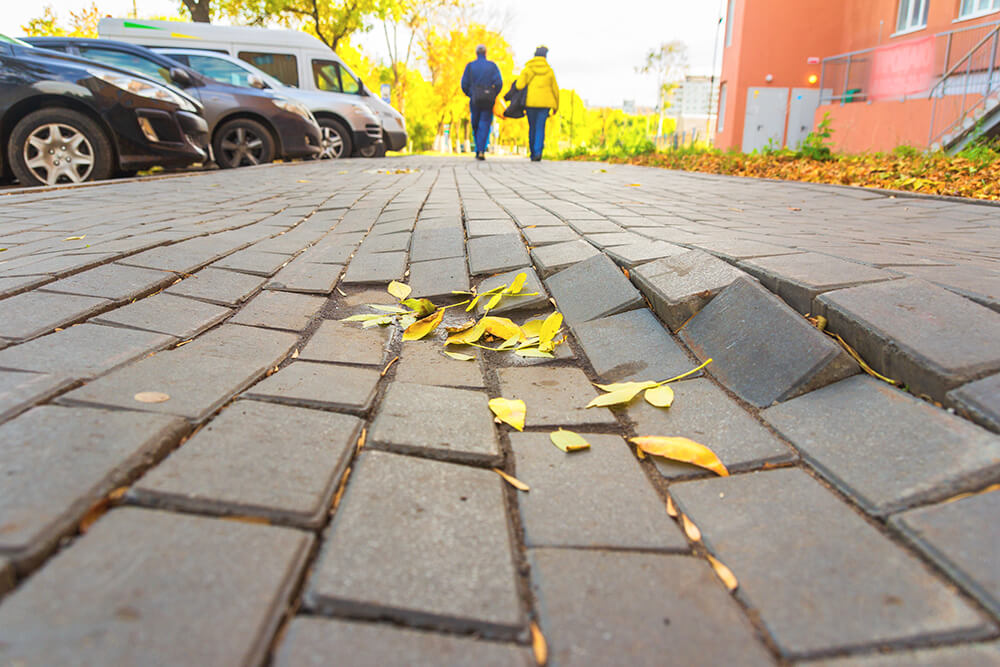Pavement Accident Claims
You may be entitled to compensation if you’ve been injured in a slip, trip or fall accident while walking on pavement. The right to pavement accident compensation, though, is not automatic. Bringing a successful personal injury claim against the local council responsible for maintaining the pavement where you fell is not always as easy as you may think. Get legal advice and assistance to bring a claim against the council. It’s vital if your accident claim is to succeed!
At Mooneerams Solicitors, we only deal with personal injury claims. Over the twenty-two years since Mooneerams opened its doors, we’ve successfully won many pavement trip compensation cases. We get the maximum compensation possible for our clients, too. We usually fund cases on a No Win No Fee basis, meaning you have no legal fees to pay anyone if you don’t win your claim.
Have you been injured in a pavement fall and want to ask someone from our award-winning personal injury team about the possibility of making a pavement compensation claim?
Call Mooneerams solicitors on 029 2199 1927 and speak with one of our personal injury experts confidentially and without obligation. If you prefer, contact us online and ask for a callback. You can send your contact details to us using the form on this page or by going to our Contact Us page.
What do we mean by a pavement accident?
Most pavement accidents are slip, trip and fall accidents by any other name. You may also hear them referred to as accidents in public places, council claims or council accidents.
The usual culprit when an unwary pedestrian trips over on the pavement is a defect in the floor surface. Injuries often result from falling to the ground after the trip. Other common reasons people trip, slip and fall on public pavements are falls caused by:
- Broken paving stones
- Damaged kerbs
- Raised paving slabs
- Potholes in the path
- Loose and wobbly paving slabs
- Inadequate street lighting
- Broken or missing manholes and other utility covers
- Tree roots that have broken through the surface of the pavement and become trip hazards
- Incorrectly laid paving stones
- Poor pavement maintenance with multiple faults present
Who is responsible if I have a trip or fall accident caused by a defect in the pavement?
If you meet the conditions for bringing a personal injury claim, responsibility for an accident on the pavement will rest with the local authority. An Act of Parliament called the Highways Act 1980 makes the highway authority responsible for the maintenance (and repair) of any highway which is ‘maintainable at the public expense’. Since the Highways Act defines a ‘highway’ as a road and a footpath, a pavement is ‘maintainable at the public expense’.
What must I do to make a successful pavement accident claim against the local authority?
So you’ve had an accident, probably in one of the ways mentioned above. As pointed out, the local authority is responsible for maintaining and repairing the uneven pavement you fell on.
If you’ve tripped and fallen on a defect in the pavement, is it simply a case of writing to the local authority to get paid an amount of compensation? Sadly, that’s highly unlikely. One letter asking for compensation will not bring you compensation for a tripping accident. Here’s why:
- The defect must have been at least 2.5 cm in height to stand any chance of bringing a successful council claim.
- If you consider suing the council for personal injury compensation after an accident, you must provide proof of the type of injury you suffered and how bad it was.
- Getting medical treatment for an injury sustained in a council accident should be your main priority.
- Depending on how badly hurt you are after the accident, you will decide to go (or get taken) to A&E or wait for an appointment with your GP.
- Hire an experienced firm of public liability claims solicitors like Mooneerams, and they will write to your GP or the hospital you visited after the accident. In the letter, they will request a brief medical report or a letter confirming that you attended to seek treatment for the injuries suffered in the pavement accident.
- A bit down the line, your solicitor will arrange for you to be examined by a specialist medico-legal doctor. This person regularly prepares medical reports for people who suffer injuries in accidents where a claim is being made.
- The medical expert will ask for authority to see your medical notes. If the notes show that you got medical attention after the accident, the medical expert will refer to it in their medical report. It’s just further evidence that your injury is genuine and that you received treatment as soon as possible.
You have three years to bring a claim against the council following a pavement accident. If you leave it too late and don’t start your claim within three years, you will be out of time, and your pavement injury claim will be time-barred.
Is there a minimum size of pavement defect required before making a successful pavement claim?
Pavement defects must be of a certain height or depth (at least 1 inch or 2.5 cm) for tripping on the pavement claims to have any chance of succeeding. However, even if you prove the required depth is sufficient to support a claim, the council may still be able to defend any injury claim brought against it.
Do local authorities have any defence to a pavement accident trip or slip claim?
As previously mentioned, Section 41 of the Highways Act 1980 makes it the local council’s responsibility to maintain and, where necessary, repair defects on pavements and roads. Councils must have a system of regular inspection of pavements in place to check paths and roads for defects.
How frequently must councils inspect pavements for relevant defects?
Rather unhelpfully, the answer is, ‘it depends’. The busier the pavement, the more often it must be checked by local authority inspectors. The council must repair defects reported to it within a reasonable timeframe. What counts as a ‘reasonable timeframe’ to inspect a pavement depends on several facts, including:
- Whether a lot of pedestrians use the pavement.
- Whether the authority knew or should have known the condition of the pavement where the accident happened was likely to cause danger to pedestrians.
- If the local authority could not reasonably be expected to repair that part of the pavement before the accident, whether the council had put adequate warning signs around the defect
There is no hard and fast rule about how long the council has to repair a defect. This applies whether the fault was discovered by a local authority inspector or reported by a member of the public.
You can notify the appropriate local authority of pavement defects yourself via the government’s dedicated website.
The local authorities’ ability to defend pavement accident claims is helped by Section 58 of the Highways Act. This means that the council will have a defence to a pavement injury claim if it can show:
“the authority had taken such care as in all the circumstances was reasonably required to secure that the part of the highway to which the action relates was not dangerous for traffic.”
Some people believe this wording is vague and gives local authorities too much leeway to defend pavement accident claims.
For this reason, you shouldn’t be surprised if the council denies liability when you or your solicitor first write to it with details of your personal injury claim. They know that many people will give up on their claim if they receive a letter quoting S58 of the Highways Act as a reason for denying liability!
How can I help the chances of my pavement claim succeeding?
Gather as much evidence as you can as soon after the accident as possible. When you got injured, your priority was to seek medical treatment. So, it may be a day or so after the accident before you can return to the scene. However, you or someone on your behalf should revisit the accident scene as soon as possible and whilst there:
- Take close-up photos of the defect from various angles that clearly show the defect. The best way to prove the depth of the fault is to put a ruler next to the defect to demonstrate the height. This photographic evidence can be crucial.
- If there were witnesses, try to get their details. Then, you can contact them later for statements of what they saw. Witness statements can be hugely supportive in public injury claims.
- Check out whether any nearby CCTV cameras caught the accident. Experienced pavement accident solicitors like Mooneerams frequently request CCTV footage on behalf of clients involved in accidents on roads or pavements. However, most CCTV footage is deleted after 30 days, so you must act quickly.
- Try to take photos of the accident before you notify the local authority to tell them about your accident. Otherwise, you might find that the defects have been repaired when you go back to take photos!
- Consult a firm of experienced personal injury solicitors to handle your claim on a No Win No Fee basis as soon after the accident as soon as possible. Doing so will give you:
-
- peace of mind
- the best chance of making a successful claim
- ensure you get the maximum amount of compensation possible
What are the most common injuries after a trip or fall pavement accident?
Certain types of injury are more common features of pavement accidents, and they include:
- Broken bone or fracture injuries
- Whiplash injuries
- Head or Brain injuries
- Spinal injuries
- Back injuries
- Cuts and lacerations
- Bruising
How much compensation will I receive for a pavement accident injury claim?
It’s difficult to say with any degree of accuracy the amount of compensation you could expect from making a successful pavement accident claim. To start with, it depends on the type of injury you suffered.
There are two types of compensation (which you will often see referred to by lawyers as ‘damages’). They are:
- General damages: compensation for pain, suffering and loss of amenity
- Special damages: loss of earnings and other financial losses suffered directly due to the accident.
Only once your solicitors have sent you for a medical examination with a specialist medico-legal doctor are they able to suggest how much compensation you could expect to receive.
Your personal injury solicitors will ask a medical specialist to prepare a report on the full extent of your injuries. You will receive a copy for approval. Only then can your legal expert start to take a view on the amount of compensation you might receive.
In the meantime, you can go to our Personal Injury Compensation Calculator page to see a rough guide to what compensation is awarded for certain types of injury.
Is there a time limit for bringing a pavement accident claim?
Yes, there is. A pavement accident claim must be started within three years of the date of the accident. If you try to bring proceedings to court the day after the third anniversary of the accident that caused your injury, you’ll be time-barred. In other words, you’ll be prevented from claiming by the court.
For children under eighteen and persons with a disability, there are exceptions to the three-year rule. To find out more, visit our Accident Advice Centre.
Mooneerams The Personal Injury Solicitors
Call Mooneerams now on 029 2048 361 if you have had a pavement accident in the last three years. Alternatively, fill in one of our quick claim forms or email us at enquiries@mooneerams.com, and we’ll get back to you.





















